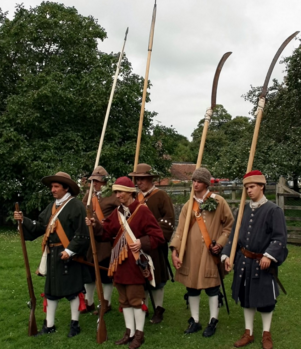





STOKE ST MARY AND DISTRICT HISTORY GROUP

STOKE ST MARY AND THE MONMOUTH REBELLION


Although Stoke St Mary has the famous “Monmouth Walk” sadly there is some doubt that Monmouth and his troops ever actually came that way into Stoke St Mary.
It is possible, nevertheless, that William Doble of Stoke Court, had one encounter with the unlucky Duke: on 18 June, l685, Monmouth, riding his white horse and leading an army of several thousand, travelled from Ilminster to Taunton by way of Shoreditch, and it seems probable that his route led him past Stoke Court.
Seven recruits came from Stoke St. Mary that day, and though all except one escaped the Bloody Assize, none was ever to be buried in the churchyard at Stoke St. Mary. William himself died peacefully in his bed two years later, and as befitted the squire, dissenter or no, he was buried by the chancel steps in Stoke Church, next to Mary his wife.
John Coleman, junior -
Philip Cornish -
Thomas Dyer -
Robert Earle -
? Griffin -
Satchell -
Daniel Manning -
DANIEL MANNING, aged 20
Blacksmith’s apprentice at Shoreditch, lived at Stoke St Mary, “absent”
Conscripted by Monmouth’s officers, marched with them to Bridgwater where he gave them the slip.
Enlisted in Col. Kirke’s regiment (the Queen Dowger’s) and marched with them to Westonzoyland; having no weapons he was not allowed into the battle.
Marched to Taunton and was discharged there with a certificate of service from Capt Thomas St. John, which twice saved him from arrest.
He sought work in London and was kidnapped on to the Golden Lyon to serve John Peirson in Barbados.
There he petitioned the Lieutenant Governor Edwyn Stede, who sent duplicate papers to the Colonial Office.
I also enclose the deposition of one Daniel Manning, who was sent by the kidnappers from London with about twenty-
He then went to London, where he was never known to have been in the rebel army, and was kidnapped and sent hither, as I have said. I send the indenture since it is not according to the appointed form, for want of which many are sent to the Colonies against their wills and contrary to the King's orders.
The examination of Daniel Manning.
Was a black-
After two days he escaped, and joined the King's army between Glastonbury and Taunton, and enlisted in Captain St. John's Company of Kirk's regiment. He was with them until after the fight of King's Edge Moor but had no arms and took no part in it, being ordered to stay at Weston, with about sixty more that had no arms, under charge of a sergeant.
Shortly after the fight he was disbanded, and received a pass from his captain, when he returned to his old master near Taunton, who however refused to receive him for fear of getting into trouble.
Examinant therefore went to London, where he was questioned whether he were not a fugitive rebel, he was cleared by his captain's certificate; but one day on Tower Hill he met with one who promised to get him employment if he would go four miles over the river, and made him sign (examinant being ill-
Taken before Edwyn Stede. 25 Jan. 1685–6.
Certified copy. 2 pp. Endorsed, Recd. 30 Mar. 1686.
There is no record of what happened to Manning in Barbados. At least one other rebel from Stoke St Mary was on Barbados and one hopes that they never met up!!
Daniel Manning’s name appears in the Rebellion exhibition at the Taunton Museum.
REBELS FROM STOKE ST MARY
Coleman, John, jun
Cornish, Phil
Dyer, Thomas
Earle, Rob
Griffin
Manning, Dan
Satchell, John
“absent in the late rebellion”
“in the late rebellion”
“absent”
aged 24, plowman [carter]. “Absent”. Tried at Taunton, transported thence for the Queen on the Jamaica Merchant 9 December; to Barbados; sold on 12 March to Captain John Sutton.
[servant to Malachi Mallack a clothier from Axminister] “absent”
yeoman “absent”
see below
Note: After Sedgemoor the Constables of the Hundreds were required to submit lists of the men of the villages in their jurisdictions who were “absent from their homes during the rebellion”. The lack of further facts implies either that the rebel was killed and buried at Sedgemoor or more probably, that he managed to stay concealed until the General Pardon was proclaimed on 10 March 1685/6.